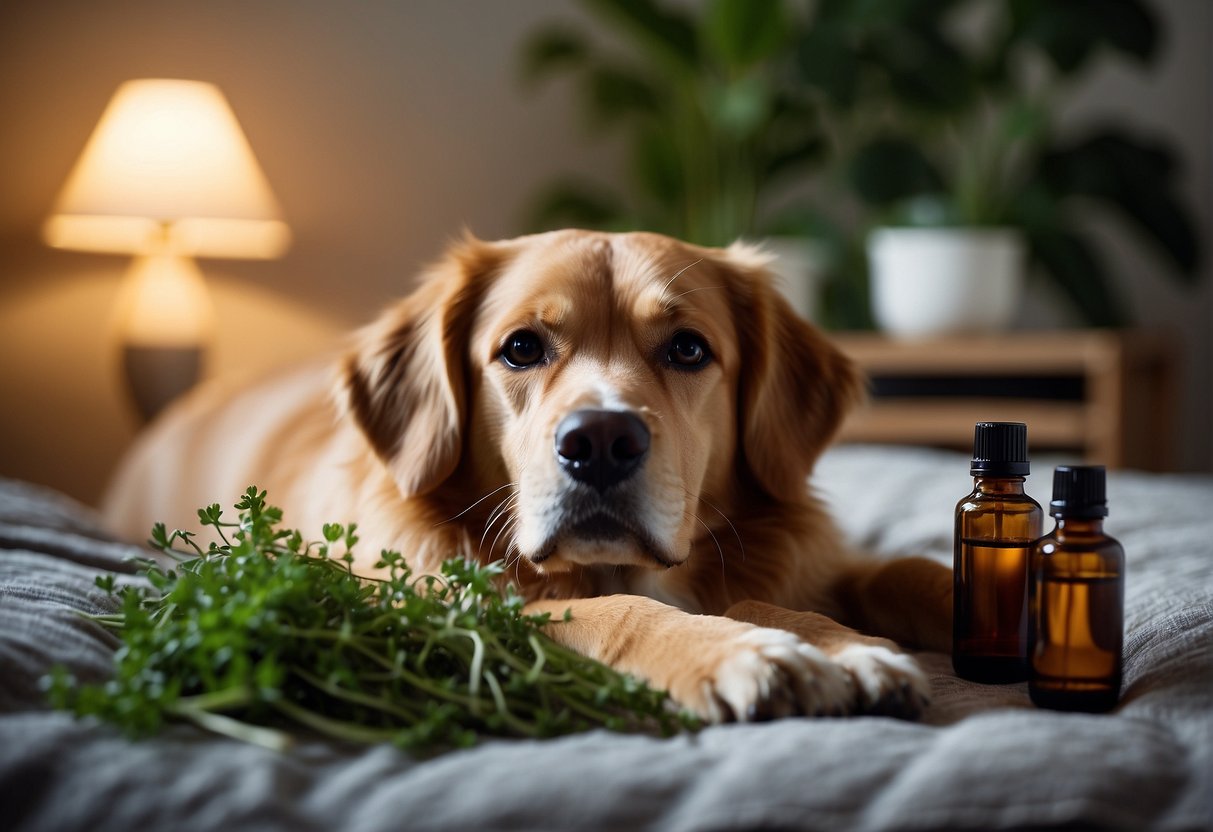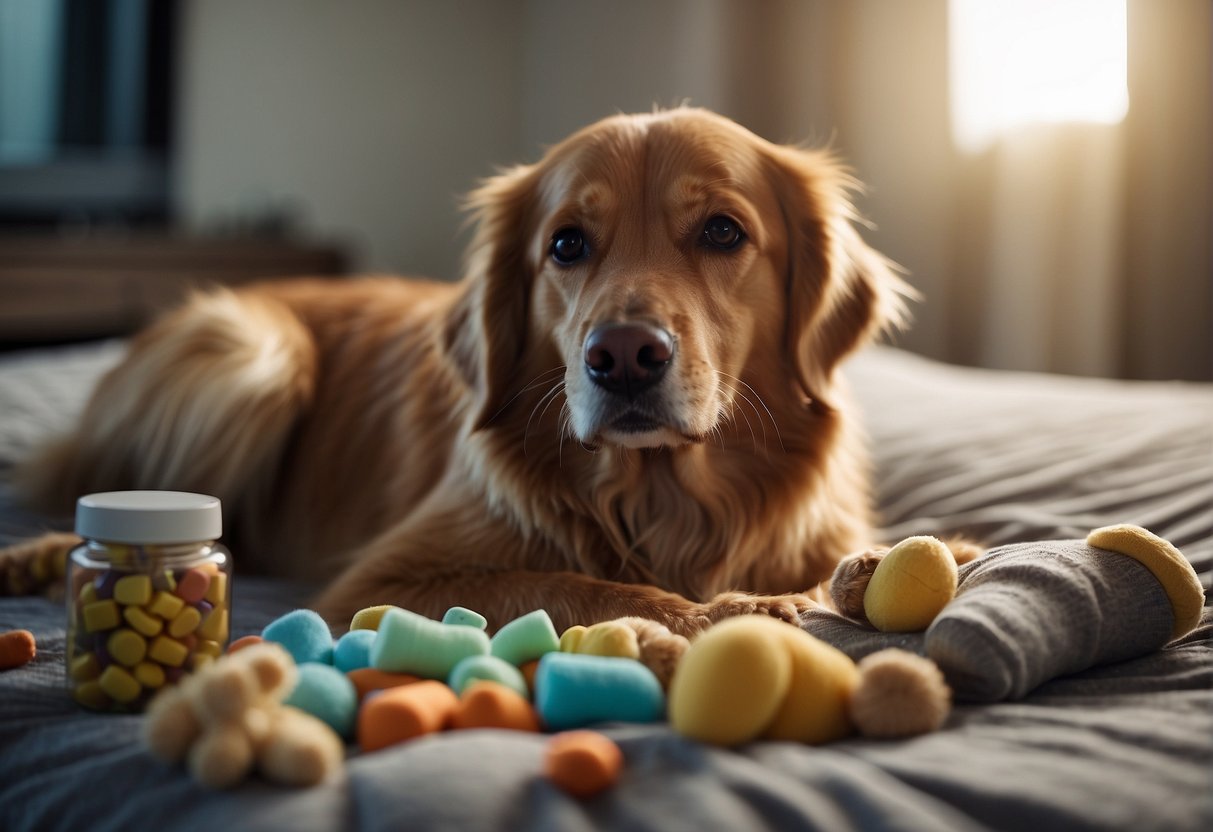Dog anxiety is an issue that many of our furry friends face, manifesting through various symptoms that can cause stress not just for them, but for us as owners.
Understanding dog anxiety is the first step in tackling it.
Anxiety in dogs can result from numerous factors, such as separation from their humans, fears of certain sounds or environments, or even changes in their routine.
Recognizing the signs of anxiety in dogs, such as excessive barking, trembling, or destructive behavior, is crucial in helping them overcome their stress.

We know how hard it can be to see our pups struggle with anxiety, and it’s natural for us to want to help them feel more at ease.
Fortunately, there are several at-home remedies we can use to alleviate our dogs’ anxious feelings.
These natural solutions can range from providing a consistent and calm environment to using specific calming techniques that can help our dogs relax.
Our bond with our dogs is strong, and we’re always looking for ways to improve their well-being.
In exploring at-home remedies for dog anxiety, we have an opportunity to enhance the quality of life for our canine companions, ensuring they’re as happy and stress-free as possible.
By taking a compassionate and informed approach, we can create a serene sanctuary for our beloved dogs, helping them to live their best lives alongside us.
Understanding Dog Anxiety

When we talk about dog anxiety, we’re addressing a significant health concern that can affect our canine friends’ overall well-being.
It’s crucial to pinpoint the reasons behind their stress and recognize the symptoms, as well as understand the distinct impact aging can have on a dog’s anxiety.
Identifying Causes and Symptoms
Dog anxiety can stem from various causes, such as fear, separation issues, or environmental changes.
Fear-related anxiety in dogs might be triggered by loud noises, unfamiliar people or animals, and new situations, all inducing stress.
Several symptoms can signal that our dog is feeling anxious:
- Physical Signs:
- Trembling
- Pacing
- Whining
- Excessive barking
- Behavioral Changes:
- Destructive behavior
- Escape attempts
- Decreased appetite
Recognizing these signs early can help us take prompt action to alleviate our dog’s distress.
Effects of Aging on Anxiety
As dogs age, they may exhibit increased levels of anxiety.
This can be due to cognitive decline or the onset of conditions such as arthritis, which can cause discomfort and contribute to stress.
Signs that aging is impacting our dog’s anxiety can manifest as increased irritability, disorientation, or changes in their sleep patterns.
It’s important for us to stay attuned to these changes so we can adjust their care and environment to help manage anxiety as our dogs grow older.
Behavioral and Training Interventions

When we tackle dog anxiety at home, it’s crucial to focus on behavioral and training interventions that create a sense of security and structure for our dogs.
These methods often involve positive reinforcement and conditioning, as well as establishing a consistent exercise and routine.
Our aim here is to mitigate symptoms like barking, pacing, and destructive behavior through tailored training sessions.
Positive Reinforcement and Conditioning
Positive Reinforcement is at the heart of reducing anxiety in dogs.
We’ve learned that rewarding desired behaviors goes a long way in helping our furry friends feel secure and understood.
For example:
- Reward Calmness: Each time our dog shows calm behavior, especially during situations that typically cause anxiety, we give them treats or their favorite toy.
- Ignore the Anxiety-Induced Behaviors: We refrain from giving attention to our dog when they display undesired anxious behaviors like barking or pacing.
This helps them learn that these behaviors do not get them the attention they might be seeking.
Conditioning, on the other hand, involves exposing our dog to the source of their anxiety in a controlled and gradual manner.
It’s important we do this in a way that allows them to remain under their anxiety threshold:
- Desensitization: We gradually expose our dog to the stressor in a controlled way.
- Counterconditioning: We change our dog’s negative response to a stressor by associating the presence of the stressor with something good, like treats or playtime.
Exercise and Routine
Establishing a Routine is vital in helping our anxious dogs.
A predictable schedule can provide a sense of security and help decrease anxiety-related behavior. This includes:
- Consistent Feeding Times: Having set times for meals helps our dogs know what to expect throughout their day.
- Scheduled Training Sessions: Holding training sessions at the same time each day can provide stability and structure.
Exercise should be an integral part of our dog’s routine.
Regular physical activity can significantly reduce their anxiety levels by:
- Burning Off Excess Energy: A tired dog is often a happy dog.
Vigorous exercise like running or playing fetch can help them feel more relaxed.
- Mental Stimulation: Incorporating games that challenge their mind in addition to their body can help reduce stress and prevent pacing or other anxious behaviors.
Natural Remedies and Supplements

When we look for ways to alleviate our furry friends’ anxiety, we often turn to natural remedies and supplements that can promote a sense of calm without relying on pharmaceuticals.
Let’s explore some herbal treatments and aromatherapy options that might offer solace to our anxious dogs.
Herbal Treatments
Herbal remedies have been utilized for centuries to help with a variety of ailments, and anxiety in dogs is no exception.
Many pet owners have found success using chamomile, which can be given in the form of a tea or as a supplement; it’s known for its gentle sedative properties, providing a calming effect.
Valerian root is another herb that’s often recommended for its ability to reduce anxiety and improve sleep without causing drowsiness during waking hours.
- Oat (in its extract form) is another herbal option that supports nervous system health.
- Calming treats frequently contain herbal blends, making them an easy option to administer these natural solutions.
It’s crucial to consult with a veterinarian before starting any herbal treatment since they can help us determine the appropriate dosage and ensure it won’t interfere with any existing medications or health conditions.
Aromatherapy and Essential Oils
Aromatherapy harnesses the calming properties of essential oils like lavender and frankincense, which can be diffused into the air to create a relaxing environment for our pets.
Research suggests that the scent of lavender, in particular, has a calming effect on dogs, which can be beneficial during stressful situations like thunderstorms or fireworks.
- Always use a diffuser in a well-ventilated area and ensure that our dogs have the option to leave the space if they want to.
- When using essential oils around pets, we ensure they are of high quality and used in a safe manner, as some oils can be toxic if applied directly to the skin or ingested.
- Pheromones designed to mimic those that mother dogs release to comfort their puppies are also available in various forms, such as collars, diffusers, and sprays.
These can serve as a natural way to soothe anxiety.
In regards to supplements, CBD oil and hemp oil are garnering attention for their potential calming effects.
Derived from the cannabis plant, these oils do not contain THC, the compound that causes psychoactive effects.
- Some studies suggest that CBD oil can help reduce anxiety by influencing the endocannabinoid system in the bodies of both humans and animals.
- Peppermint is sometimes included in blends for its refreshing scent, but we take care to use it sparingly as stronger odors may be overwhelming for a dog’s sensitive nose.
We’re aware of the importance of using natural solutions responsibly, so we always recommend speaking with a vet to ensure they align with our dogs’ specific needs and health profiles.
Professional Care and Medications

While we all want our furry friends to feel calm and happy, sometimes at-home remedies may not be enough to alleviate our dog’s anxiety.
In such cases, professional care and medications can be indispensable.
It’s essential to understand when to seek veterinary advice and what pharmaceutical options could be available.
When to Consult a Veterinarian
If you notice persistent signs of anxiety in your dog, such as excessive barking, restlessness, or behavioral changes, it’s time to consult a veterinarian.
Professional care is crucial, especially if your dog’s anxiety starts to interfere with their daily life or if you notice any physical symptoms.
A veterinarian can assess the situation, rule out any underlying health problems, and determine the best course of action, which may include prescription medication.
Pharmaceutical Options
Pharmaceutical options for dog anxiety include a range of anti-anxiety medications.
Here’s a breakdown of some common ones:
-
SSRIs: Selective serotonin reuptake inhibitors like fluoxetine (often known by the brand name Prozac) and paroxetine (Paxil) may be prescribed to help boost serotonin levels, which can stabilize mood.
-
Tricyclic Antidepressants: Medications such as clomipramine are another option and can be particularly effective for separation anxiety in dogs.
On the other side of the spectrum are anti-anxiety meds like lorazepam (a benzodiazepine), which may be used for more immediate relief in high-stress situations.
These meds should be used with caution due to potential side effects and the risk of dependency.
There are also non-prescription options that may be suggested by veterinarians for milder cases:
- Valerian root and passion flower are natural substances that have been noted for their calming effects and can sometimes be used to help soothe anxious dogs.
It’s important to remember that all medications, even those aiming to treat anxiety, should only be administered under the guidance of a veterinarian, as they will take into consideration your dog’s specific needs and health profile.
Home Management and Environmental Modifications
In managing dog anxiety, we believe it’s crucial to create a serene home environment and provide engaging items that promote calmness.
By doing so, we can significantly reduce the stress levels in our anxious canine companions.
Calming Accessories and Toys
Calming accessories like the Thundershirt, work by applying gentle, constant pressure to your dog’s body, which can provide a sense of security.
Similar to a comforting hug, this pressure can have a remarkable effect on reducing anxiety, especially during thunderstorms or fireworks.
- Puzzle toys: We find these to be especially useful for redirecting our dog’s attention from stressors and keeping them mentally stimulated.
- Interactive puzzles: Keep their mind focused and bodies active, thereby reducing anxious energy.
Music: Soft, classical music can also be an excellent tool for creating a tranquil space.
There are playlists and CDs designed specifically for canine relaxation that we have found to be effective in calming our dogs during stressful situations.
Creating a Safe Space
We always ensure that our dogs have a safe space such as a kennel or a specific room where they feel secure and can retreat to when they’re feeling anxious.
We’ve observed that:
- Padding their kennel with comfortable blankets and including a well-loved toy can make a significant difference.
- Spraying the area with calming pheromones like Adaptil, which mimics the Dog Appeasing Pheromone (DAP), helps in creating a soothing atmosphere.
By incorporating these modifications, we not only help our dogs find peace in their immediate surroundings but also foster a stronger, more trusting relationship with them.















